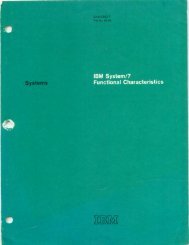Systems Reference Library - All about the IBM 1130 Computing ...
Systems Reference Library - All about the IBM 1130 Computing ...
Systems Reference Library - All about the IBM 1130 Computing ...
- No tags were found...
Create successful ePaper yourself
Turn your PDF publications into a flip-book with our unique Google optimized e-Paper software.
Standard replies as well as NAK cause an endcharacter-decodedinterrupt allowing <strong>the</strong> programto initiate line turnaround.TURNAROUND SEQUENCES: These sequences areused to cause an end-character-decoded interrupt,thus allowing <strong>the</strong> program to initiate line turnaround.Turnaround sequences are formulated by a DLEas <strong>the</strong> leader, followed immediately by any of <strong>the</strong>turnaround characters indicated in Figures 93 and94The character sequence DLE turnaround can beused as an acknowledgment to which a specialmeaning may be assigned by prior agreement.Turnaround character sequences are not recognizedif SOH or STX has been previously detected in<strong>the</strong> message stream.Data Transmission CheckingData checking is based upon transmission of additionalinformation with each transmission block ofdata (heading and/or text blocks). This extra informationpermits error detection by <strong>the</strong> receiving station.This information is called a block checkcharacter (BCC). The three checking methods usedto generate BCC's are described next.CYCLIC REDUNDANCY CHECK (CRC-16): Thischecking is performed automatically by <strong>the</strong> lineadapter and is used only with EBCDIC in both normaland transparent modes. CRC produces a 16-bitcheck character by an arithmetic accumulation of<strong>the</strong> message bits for each transmission block. This16-bit CRC character is transmitted as two contiguousBCC's immediately following <strong>the</strong> end-of-blockcharacter. The receiving station also produces itsown CRC character using <strong>the</strong> same method. This16-bit CRC character is compared for agreementwith <strong>the</strong> two BCC's received. If <strong>the</strong>y do not agree,a BCC error is set in <strong>the</strong> device status word.CRC accumulation begins following <strong>the</strong> firstappearance of an SOH or STX in normal mode or anSOH or DLE STX in transparent mode. The SOH,STX, or DLE STX is not included in <strong>the</strong> accumulation.CRC accumulation ends with and includes <strong>the</strong>end-of-block character (ITB, ETB, or ETX). IfITB is <strong>the</strong> end-of-block character, CRC accumulationfor <strong>the</strong> next block begins automatically withoutan SOH or STX. <strong>All</strong> characters transmitted orreceived during accumulation are included, exceptthose characters that are not sent to core storage at<strong>the</strong> receive station. These characters are: SYNSYN, DLE SYN, or first DLE in DLE DLE sequence.VERTICAL REDUNDANCY CHECK (VRC): VRC isperformed automatically by <strong>the</strong> line adapter and isused only with ASCII in normal mode. This codestructure defines an eighth bit to provide odd parityfor each character. A vertical redundancy check(parity) is performed on each character; if its parityis not odd, data parity error is set in <strong>the</strong> devicestatus word. The VRC check is made on all transmissions:responses, control sequences, headings,and text.LONGITUDINAL REDUNDANCY CHECK (LRC):LRC is performed automatically by <strong>the</strong> line adapterand is used only with ASCII in normal mode. TheLRC character is an eight-bit character. It consistsof <strong>the</strong> bits necessary to make <strong>the</strong> total numberof 1-bits even in each individual bit level of <strong>the</strong> codefor <strong>the</strong> entire transmission block. The LRC characteris transmitted as one BCC immediately following<strong>the</strong> end-of-block character. The receiving stationproduces its own LRC character, which is comparedfor agreement with <strong>the</strong> BCC received. If<strong>the</strong>y do not agree, a BCC error is set in <strong>the</strong> devicestatus word.LRC accumulation begins after <strong>the</strong> first appearanceof an SOH or STX. The first SOH or STX is notincluded in <strong>the</strong> accumulation. LRC accumulationincludes and ends with <strong>the</strong> end-of-block character(ITB, ETB, or ETX). If ITB is <strong>the</strong> end-of-blockcharacter, LRC accumulation for <strong>the</strong> next block beginsautomatically without an SOH or STX. <strong>All</strong> characterstransmitted or received during accumulationare included except those characters that are notsent to core storage (SYN SYN).Transparent Mode ControlTransparent mode allows <strong>the</strong> full 256 EBCDIC charactercodes to be transmitted as text. Transparentmode is used when binary information, or externalcodes are to be transmitted or received. No provisionfor transparent mode operation using ASCII isprovided.A line adapter enters transparent mode after aDLE STX sequence. In transparency, a transmittingline adapter inserts a second DLE after eachdata DLE received from core storage. For example,a DLE ETB sequence transmitted during transparentmode appears as a DLE DLE ETB sequence, and <strong>the</strong>control character sequence of DLE ETB is not recognized.At <strong>the</strong> receiver, <strong>the</strong> DLE preceding <strong>the</strong>inserted DLE is deleted and not sent to core storage.A line adapter leaves transparent mode when asingle DLE followed by an ITB, ETB, ETX, or ENQ184
















